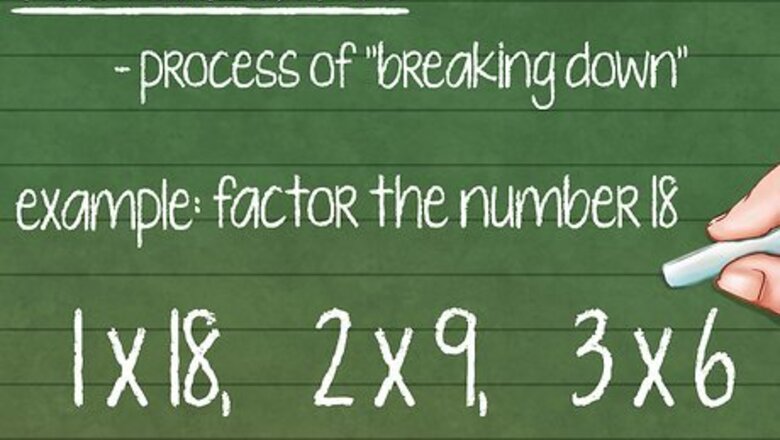
views
Finding Prime Factorization
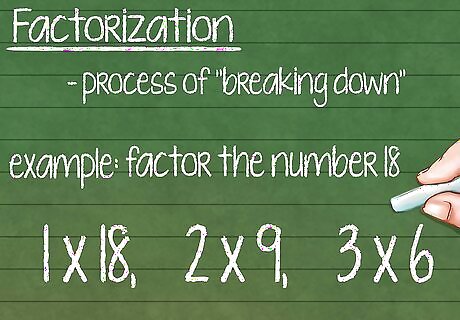
Understand factorization. Factorization is the process of "breaking down" a number into smaller parts. These parts, or factors, multiply with each other to equal the original number. For example, to factor the number 18, break it into 1 x 18, or into 2 x 9, or into 3 x 6.
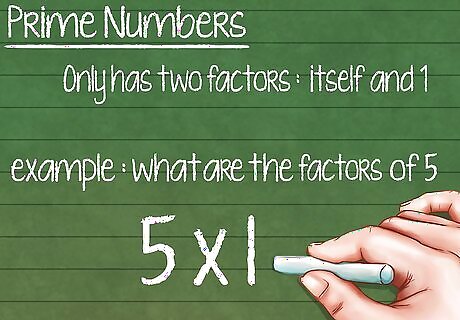
Review prime numbers. A prime number only has two factors: itself and 1. The number 5, for example, is the product of 5 and 1. You can't break it down into any other numbers. The goal of prime factorization is to keep breaking a number down until there are only primes left. This is especially useful when handling fractions, making them easier to compare and use in equations.
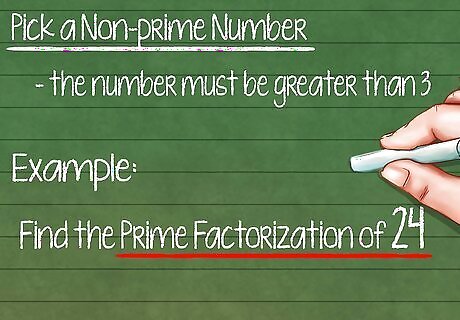
Start with a number. Pick any non-prime number greater than 3. There's no point starting with a prime number, since there's no way to factor it. Example: In this guide, we'll find the prime factorization of 24.
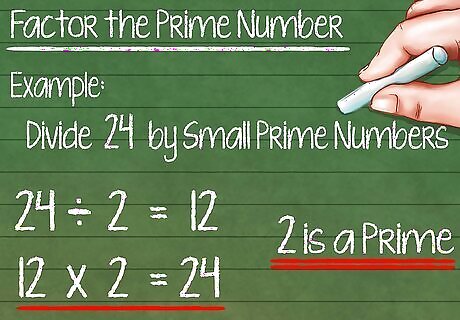
Factor it into any two numbers. Find any two numbers that multiply together to make the number you started with. You can use any two you can think of, but a prime number will make your work easier. One good strategy is to try dividing the number by 2, then 3, then 5, working your way up through the prime numbers until you find one that divides evenly. Example: If you don't know any factors of 24, try dividing it by small prime numbers. Let's divide by 2 to get 24 = 2 x 12. We're not done yet, but this is a good start. Since 2 is prime, this is an easy way to start when factoring any even number.
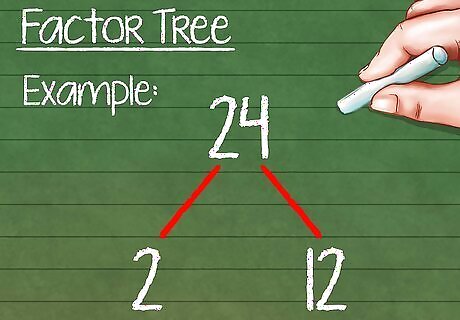
Start making a factor tree. A factor tree is an easy way to keep track of a factorization problem. To start one, just draw two "branches" splitting down from the original number. Write your two factors at the end of these branches. Example: 24 /\ 2 12
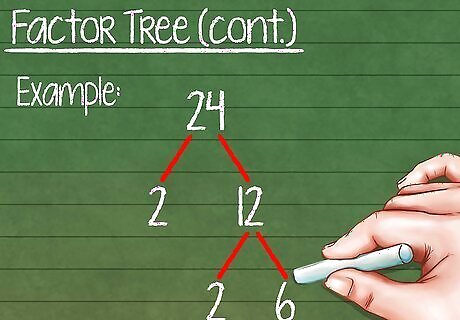
Factor the next line of numbers. Look at your two new numbers (the second line on your factor tree). Are they both primes? If one of them isn't a prime, factor it again the same way. Draw more branches on the tree and write the new factors on a third line. Example: 12 is not a prime, so we factor it again. Let's use 12 = 2 x 6 and add it to the factor tree: 24 /\ 2 12 /\ 2 x 6
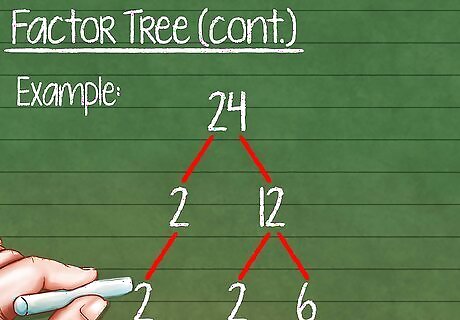
Bring down prime. If one of the factors is prime, bring it down onto the next line with its own single "branch." There's no way to break it down further, so we're just keeping track of it for now. Example: 2 is a prime number. Bring the 2 from the second line down to the third. 24 /\ 2 12 / /\ 2 2 6
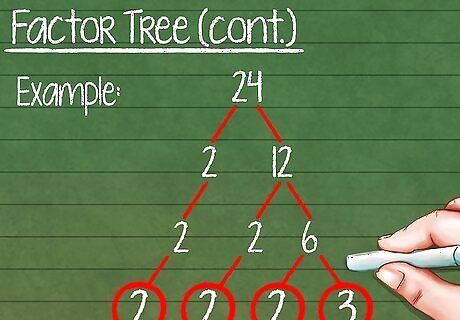
Keep factoring until you're left with only primes. Check each new row on the factor tree once you write it. If any of the numbers can be factored again, make a new row. You're finished once there are only prime numbers left. Example: 6 is a non-prime number and needs to be factored again. 2 is a prime number, so we just bring the 2s down to the next row. 24 /\ 2 12 / /\ 2 2 6 / / /\ 2 2 2 3
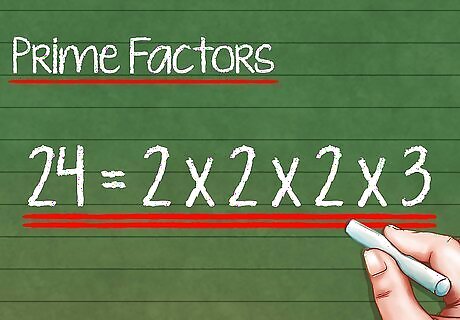
Write the final line as your prime factors. Eventually, you'll only have prime numbers left. When this happens, you're done factoring. The prime factorization is the entire, last line of numbers, written as a multiplication problem. Check your work by multiplying the last line together. It should equal the original number. Example: The final line of our factor tree has nothing but 2s and 3s. These are both primes, so we're finished. We can write the prime factorization of 24 as 24 = 2 x 2 x 2 x 3. The order of the factors does not matter. 2 x 3 x 2 x 2 is also a correct answer.
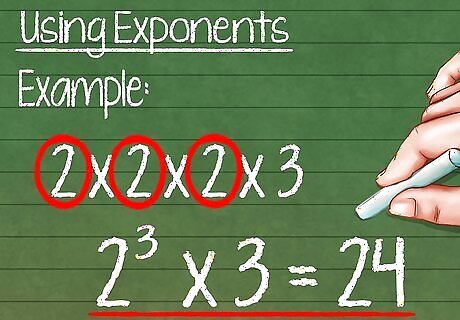
Simplify using exponents (optional). If you know how to write exponents, you can make the prime factorization easier to read. Remember, an exponent is a base number, followed by a number that states how many times the base is multiplied. Example: In the factorization 2 x 2 x 2 x 3, how many times does 2 appear? Since the answer is "three," we can simplify 2 x 2 x 2 with 2. The simplified prime factorization is 2 x 3.
Using Prime Factorization
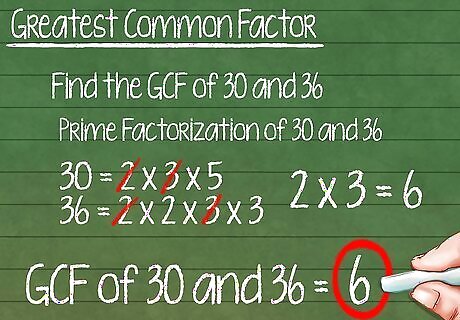
Find the Greatest Common Factor of two numbers. The Greatest Common Factor (GCF) of two numbers is the largest number that's a factor of both numbers. Here's how to find the GCF of 30 and 36, using prime factorization: Find the prime factorizations of the two numbers. The prime factorization of 30 is 2 x 3 x 5. The prime factorization of 36 is 2 x 2 x 3 x 3. Find a number that appears on both prime factorizations. Cross it out once on each list and write it on a new line. For example, 2 is on both lists, so we write 2 on a new line. We're left with 30 = 2 x 3 x 5 and 36 = 2 x 2 x 3 x 3. Repeat until there are no more factors in common. There's also a 3 on both lists, so write it on your new line to make 2 and 3. Compare 30 = 2 x 3 x 5 and 36 = 2 x 2 x 3 x 3. There are no more numbers left in common. To find the GCF, multiply all the shared factors together. We just have 2 and 3 in our example, so the GCF is 2 x 3 = 6. This is the largest number that is both a factor of 30, and a factor of 36.
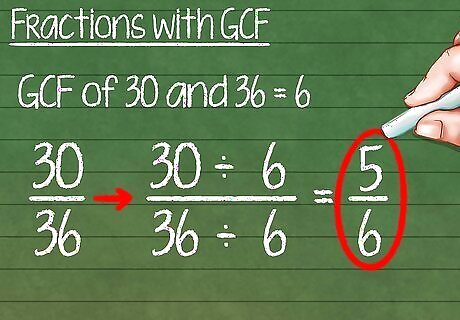
Simplify fractions with the GCF. Use the Greatest Common Factor whenever you suspect a fraction is not in simplest form. Find the GCF of the numerator and denominator, using the process above. Once you've found it, divide both parts of the fraction by the GCF. The answer will be the same fraction in simplest form. For example, simplify the fraction /36. We already found out that the GCF is 6, so divide both the numerator and denominator by 6: 30 ÷ 6 = 5 36 ÷ 6 = 6 /36 = /6
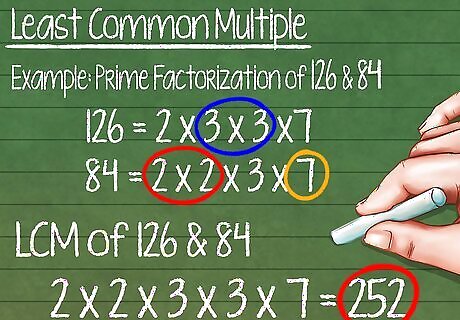
Find the Least Common Multiple of two numbers. The Least Common Multiple (LCM) of two numbers is the smallest number that has both of the first two numbers as factors. For example, the LCM of 2 and 3 is 6, because it has both 2 and 3 as factors. Here's an example of finding LCM from prime factorization: Start with two prime factorizations. For example, the prime factorization of 126 is 2 x 3 x 3 x 7. The prime factorization of 84 is 2 x 2 x 3 x 7. For each unique factor, compare the number of times it appears in each list. Pick a list where it appears the greatest number of times, and circle each instance. For example, 2 appears once in the factors of 126, but twice in the list for 84. Circle the 2 x 2 in the second list. Repeat for each unique factor. For example, 3 appears most often in the first list, so circle the 3 x 3 there. 7 only appears once on each list, so circle a single 7. (It doesn't matter which list you choose when there's a tie.) Multiply all of your circled numbers together to find the LCM. In our example, the least common multiple of 126 and 84 is 2 x 2 x 3 x 3 x 7 = 252. This is the smallest number that has both 126 and 84 as factors.
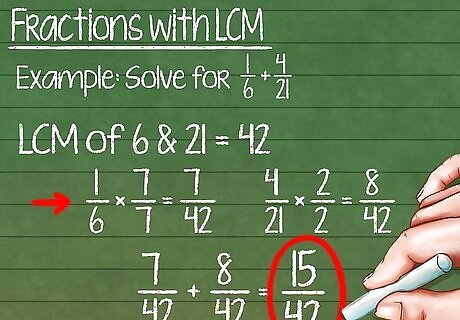
Use the LCM when adding fractions. Before you can add two fractions together, their denominators must be the same. Find the Least Common Multiple of the two denominators. Multiply each fraction so that the new denominator is the LCM. Once both fractions are in this form, you can add them together. For example, we want to solve /6 + /21. Using the method above, we can find the LCM of 6 and 21. The answer is 42. Turn /6 into a fraction with 42 as the denominator. To do this, solve 42 ÷ 6 = 7. Multiply /6 x /7 = /42. To turn /21 into a fraction with 42 as the denominator, solve 42 ÷ 21 = 2. Multiply /21 x /2 = /42. Now that we have the fractions in forms with the same denominator, we can add them together easily: /42 + /42 = /42.




















Comments
0 comment